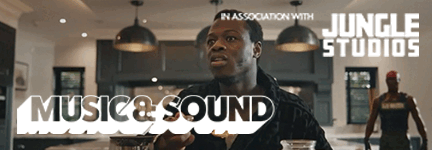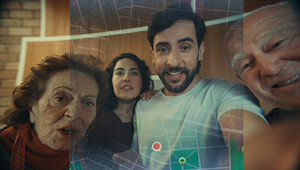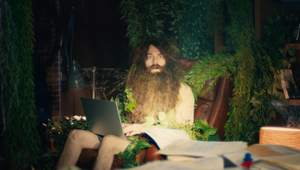
Thinking in Sound: For Timothy Bridge, It's All Music, All the Time

Since taking the helm as head of sound at Sonar in 2021, Timothy Bridge has made a name for himself among some of Australia’s most reputable agencies and production houses.
He's collaborated with Australia's elite on campaigns for big names like Mastercard, Audi and McDonald’s. His magic touch on Samsung’s Cannes Grand Prix-winning 'Flipvertising' campaign speaks for itself. With his work getting nods from the ASSG, LIAs, Cannes Lions and more, it's clear Timothy's audio game is on point.
LBB> When you’re working on a new brief or project, what’s your typical starting point? How do you break it down and how do you like to generate your ideas or response?
Timothy> After a few play throughs, both with and without the temp, I usually figure out the biggest moments for both sound and music, as well as any hero dialogue. This gives me a framework to work within. Naturally, the ideas start forming from the brief, then I like to throw some sounds in and quickly see if they work tonally; for example, something might immediately feel too heavy or whimsical and then the direction has to pivot.
LBB> Music and sound are in some ways the most collaborative and interactive forms of creativity - what are your thoughts on this? Do you prefer to work solo or with a gang - and what are some of your most memorable professional collaborations?
Timothy> I'm lucky enough to work in a studio where collaboration has been fundamental since its inception. From composers to sound designers, and everything in between, I consistently find that collaboration is crucial to any good final product.
The magic starts with the dance that music and sound engage in; inspiration often comes from one side bouncing initial ideas off the other. I always like to sense check my progress with my team, gathering honest responses and feedback along the way to help fine tune the story telling.
I just recently finished the first episode of a docu-series called 'The Art of Sound', which explores the fundamentals of sound. It’s a hugely ambitious three-part series, with the first episode featuring David Byrne. This episode was scored by one of Sonar's own, Jackson Milas, who brought so much life to the project. It’s incredibly immersive, recreating experiences through sound and exploring the power sound can have on people. I mixed the 7.1.4 and the final product will be available in binaural as well.
LBB> What’s the most satisfying part of your job and why?
Timothy> Definitely the final mix, when everyone’s collaborative hard word gets seen and heard for the first time. I've had really moving sessions where people have gotten emotional after seeing a project they have been working on (sometimes for years) finally complete for the first time. That never gets old.
LBB> As the advertising industry changes, how do you think the role of music and sound is changing with it?
Timothy> Change is inevitable and with change comes progress. The progress of technology has reshaped the landscape we work in from every angle; the sound and music process is not excluded in this.
In some ways it has made our work more efficient and of a much higher quality, though this is only possible with the direction, expertise and creativity of a skilled professional who is constantly learning about and integrating the latest products and techniques. Essentially, I've witnessed these changes affording advertisers greater value for money.
For me, personally, I have more opportunity to try new things, test different approaches, and easily reshape pieces with the right sound or element. Shorter formats and new platforms add new challenges too, sometimes requiring new approaches or reviving old trends - sonic branding is just one that comes to mind.
LBB> Who are your musical or audio heroes and why?
Timothy> Jaco Pastorius. As a bass player, it's hard for me to look past him. He was an innovator, and he surely made a mark on me as a young musician.
LBB> When you’re working on something that isn’t directly sound design or music (lets say going through client briefs or answering emails) - are you the sort of person who needs music and noise in the background or is that completely distracting to you? What are your thoughts on ‘background’ sound and music as you work?
Timothy> When I'm not sound designing, I like to have the studio door open so I can hear the chatter of people coming and going in the studios. Sometimes, I am door closed, beavering away on emails and have a favourite playlist or new album on to tap away to.
But mostly, I find the pockets of silence in the studio comforting, especially if it's a busy work period and I'm active listening for long periods.
LBB> I guess the quality of the listening experience and the context that audiences listen to music/sound in has changed over the years. There’s the switch from analogue to digital and now we seem to be divided between bad-ass surround-sound immersive experiences and on-the-go, low quality sound (often the audio is competing with a million other distractions) - how does that factor into how you approach your work?
Timothy> I have to be bolder with mixes these days, knowing the work I'm producing is often going to be listened to on a phone in the back of a taxi on the way to the airport. I also have to reference my mixes on laptops and phones to ensure it translates. Technically speaking, we are also very conscious not to have too much low end that cannot be replicated by the smaller speakers on our devices.
LBB> On a typical day, what does your ‘listening diet’ look like?
Timothy> I love a good podcast, especially for my morning commute. Usually, I'm listening to something sound design-related or finance/news-related. But at home, it's pretty much all music, all the time.
LBB> Do you have a collection of music/sounds and what shape does it take (are you a vinyl nerd, do you have hard drives full of random bird sounds, are you a hyper-organised Spotify-er…)?
Timothy> I have a pretty varied music collection, stacks of CDs, some cassettes and vinyl. Nothing meticulously curated! I'm definitely a music streamer these days. My personal sound effects library, however, is a Google Drive loaded with miscellaneous sounds I’ve recorded and collected over the years, stuffed into folders that make sense to me.
LBB> Let’s talk travel! It’s often cited as one of the most creatively inspiring things you can do - I’d love to know what are the most exciting or inspiring experiences you’ve had when it comes to sound and music on your travels?
Timothy> I was recently in London and I don't think anyone could ever forget seeing and hearing the St Paul's Cathedral Choral Evensong, with its impressive 11 second reverb time. All cathedrals share that incredible presence that reminds me of the power of sound.
LBB> As we age, our ears change physically and our tastes evolve too, and life changes mean we don’t get to engage in our passions in the same intensity as in our youth - how has your relationship with sound and music changed over the years?
Timothy> My personal relationship with music and sound has changed dramatically over the years. As someone who started playing in bands, recording bands on tours and in studios, and then shifting to full time sound design, its been a gift to be so musically engaged when sound design and music are so blurred, I just now see it from a new sound driven perspective.















